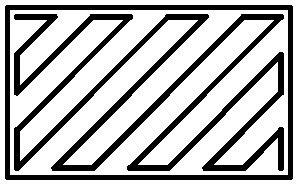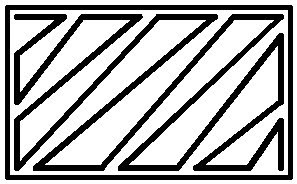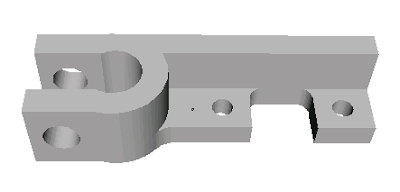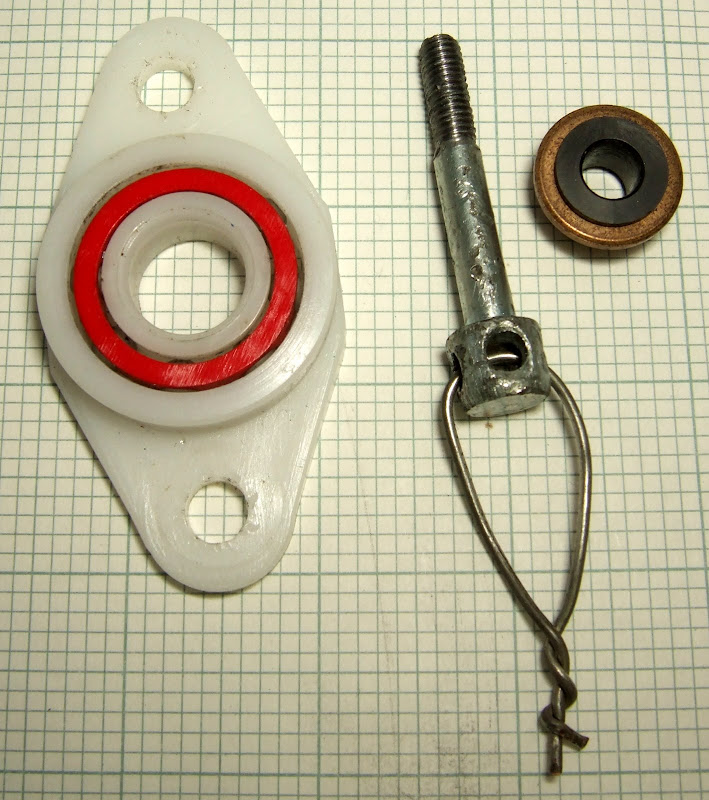Adrian Bower has kindly given me a small sample of
polylactic acid (PLA) filament to evaluate and some parts to make the new geared extruder are on their way. Being a bit too impatient I decided to try extruding it with my current extruder.
Each polymer I have tried so far (HDPE, PCL and ABS) has had very different characteristics and PLA is very different again. At room temperature it is very hard and brittle and is completely transparent. At somewhere between 50-80°C it has a glass transition temperature above which it becomes a rubbery jelly. If you put it in boiling water and then pick it out with tongs you can bend it as much as you want and when it cools it will set in that shape. These are the two bits of 3mm filament I showed earlier when I had bent a 150mm piece double and it snapped :-

After dipping them in boiling water I could tie knots in them but I had to be quick because it hardens in seconds. If I return them to boiling water they untie themselves and return to being a straight rod.
PLA melts at about 175°C, the highest of all the polymers I have tried so far, where it transitions from jelly to a liquid with the consistency of a thin syrup. If you extrude it quickly into mid air it sets almost instantly and forms a filament, but if you extrude it slowly it forms drops that drip from the nozzle like water from a tap, but are solid when they hit the deck. Very different from HDPE and ABS which extrude more like a paste. Like PCL, PLA is sticky when molten so it sticks to MDF quite well, unlike HPDE and ABS.
Getting it to extrude from the original extruder is next to impossible, I really should have waited for the gears. The problem is that the extruder pumps the filament by cutting a thread into it. PLA is so hard that it needs an enormous force to press the thread into its surface. That is no problem with the springs I have, but it also seems to have a high coefficient of friction, so the torque required to turn the thread is then too much for the GM3 gearmotor and its clutch slips.
Recently I had an idea to cut the torque requirement by shortening the thread. The reasoning goes like this: -
A substantial part or perhaps most of the force required to push the polymer is not the extrusion pressure but the lateral friction of pushing the filament through the filament guide and the tangential friction of cutting the thread. Both of these are equal to the respective coefficients of friction multiplied by the force exerted by the springs. But the force required to achieve enough pressure to push the thread into the plastic must be proportional to the length of contact. So once you have enough thread to push the filament without shearing off, any more is counter productive. It requires more spring force, which creates more friction, which makes the filament harder to push, a vicious circle.
Ian Adkins put the theory to the test and reported he could still extrude PCL with only 7mm of thread. The motor current dropped from 240mA to 190mA. The no load current was 62mA so that indicates about a 50% reduction in torque required. Not being as brave as Ian, I reduced mine a bit less radically to start with. I roughly halved it: -

I used a couple of washers at the top set of screws to space the pump halves apart, to keep them parallel, and just tightened the bottom pair of springs. That did reduce the torque required but even with plenty of oil the GM3 clutch was still slipping. It is a good modification because you save two springs, hence two less adjustments, and the extruder is quicker to strip down and rebuild. Plus future versions of the pump can be made much shorter.
All the adverts for the GM3 say the clutch can easily be locked but don't say how. I opened the gearbox and found the clutch is inside the last gear wheel. I tried putting some bits of thick wire into it to stop the springy bits from compressing.

That worked for a while until one fell out. I thought they would be trapped by the lid but seemingly not. My next attempt was to stick them in with super glue. That worked but the clutch still slips somehow.
Another issue with PLA is that the filament likes to rotate in the pump. Other polymers do that as well, but if you hold them so they can't rotate they still extrude. With PLA, if you don't let it rotate it slows down the motor. Presumably by letting it turn it removes the tangential friction leaving only the sliding friction. The problem with letting it rotate is that I think it means the forward motion is less so the extrusion rate is not what it should be.
When the clutch slips it jumps one notch. Because my shaft encoder is on the output shaft the firmware makes up the difference. If it does not happen too often I still get the right volume extruded. It does however cause a shock wave which makes a blob in the extruded filament. I decided to try and make an object anyway with it slipping occasionally.
Because I only had 8m of filament I decided to try a sparse filled object first. That does not work with PLA because the unsupported filaments sag: -

However, this messy object has a perfectly flat base so shows some promise.
Next I tried a 100% filled block, extruded at 180°C (at the nozzle) 0.75mm filament at 8mm/s, layer height 0.6mm, pitch 0.9mm, fan on continuously. A bit slow and course compared to my other tests but I always start slow and move up in speed.

During this build the clutch started slipping once or twice per revolution causing the warty surface. Near the end it started slipping continuously so this is only about 18.5mm high rather than my standard 20mm test. Never the less, it only has 0.19mm warping after more than 24 hours making it the least warping yet for a solid object. Added to that it is probably the hardest material of the four.
PLA's main downside is the low temperature at which it goes soft, not much better than PCL, even though it has a much higher melting point. In this respect it is very like PVC which also has a high melting point and a glass transition around 80°C.
Here is my warped league: -

I think I can explain why plastics are good and bad for warping. It is simply how much they contract between the point they go solid and room temperature.
HDPE has a high freezing point and high thermal coefficient.
ABS has a slightly lower freezing point and a low thermal coefficient.
PCL has a very low freezing point.
PLA has a glass transition point not much higher than room temperature.
If the object can be stuck to a rigid base while it is cooling then the warping is reduced.
My theory of needing to extrude at twice the melting point minus ambient certainly does not hold for PLA, otherwise I would need to extrude it at 330°C. I get very good bonding at 180°C. It may be that if I extrude very fast it would need to be hotter but I expect it would decompose at 330°C. It may be that the glass transition makes the theory invalid or maybe it is plain wrong. It does seem to be true for polymers which are paste like and not sticky, i.e. ABS and HDPE. PCL and PLA are both sticky when molten. I.e. they will stick to things like glue does whereas HDPE will only weld to things like itself. It has no adhesive quality.
I haven't entirely given up with making the non geared extruder work with PLA. The problem with the geared version is that it can't keep up with my extrusion speeds. I can try reducing the thread even more. I can try sharpening it as Vik Olliver has done. I can find a solution to locking the clutch. The motor does get quite hot so it probably won't last long. I do have three more to burn through before I find a better motor. They only seem to last a couple of weeks in my machine anyway.


































